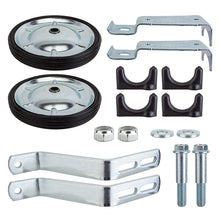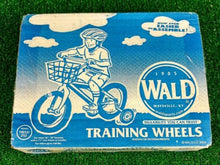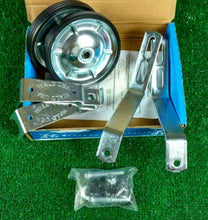
- Fits 16 to 20"
- Fits bikes w/up to 1.25" rear chain stays
- Steel Wheels
- Maximum rider weight: 100lbs
- Includes adapters to work with .75 and 1" chain stays
The Wald training wheels for kids bikes are designed to fit a range of wheel sizes from 12 to 20 inches, including the popular 16-inch size often found on children's bikes. These training wheels are made from durable steel and feature rubber tires for a smooth and quiet ride.
The Unervars model from Wald is adjustable to fit a range of frame sizes and is easy to install with the included hardware. These training wheels are designed to help kids learn to ride with confidence and stability, making the transition to riding without training wheels smoother and safer.
It's important to note that while training wheels can be a helpful tool for young riders, it's important to also teach and encourage proper balance and technique to ensure a safe and enjoyable riding experience. It's recommended to gradually raise the training wheels over time to encourage balance and coordination.


Bicycle Training Wheels: How to Use Them to Teach Your Kids to Ride Without Them
Learning to ride a bicycle is a rite of passage for many children, and bicycle training wheels can be an invaluable tool in helping kids gain the confidence and balance necessary to ride on two wheels. In this article, we will discuss how to use training wheels effectively to help your child learn to ride a bike and offer some tips on when to consider using heavy-duty adult training wheels and specialized training wheels for special needs individuals.

When to Use Training Wheels
The age and weight at which a child is ready to use training wheels will vary depending on the child's physical development and coordination. Generally, children between the ages of three and six years old are good candidates for training wheels. As for weight, training wheels can typically accommodate children up to 75 pounds.

When choosing a bike, make sure it's the right size for your child. A bike that's too big or too small can make it more difficult to learn to ride. When your child sits on the bike, they should be able to touch the ground with both feet flat on the ground. The handlebars should be within easy reach, and the child should be able to reach the brakes comfortably.

How to Use Training Wheels
Before you attach the training wheels to the bike, make sure the bike is in good condition. Check the brakes, tires, and chain to ensure that everything is working properly. Next, attach the training wheels to the rear axle of the bike. Adjust the height of the training wheels so that they are just off the ground. You want them to provide stability to the bike, but you don't want the bike to lean too much to one side or the other.
Once the training wheels are attached, have your child sit on the bike and practice pedaling. Encourage them to steer and practice turning. As they become more comfortable, gradually raise the training wheels off the ground by a few millimeters. Continue to do this until the wheels are no longer touching the ground. The goal is to help your child gain the balance and coordination necessary to ride without training wheels.

Heavy Duty Adult Training Wheels
If you're an adult who is learning to ride a bike for the first time, or you're someone who needs extra support due to a physical disability or condition, heavy-duty adult training wheels can be a helpful tool. Heavy-duty training wheels are designed to support more weight and provide more stability than standard training wheels.

When to Consider Specialized Training Wheels
For individuals with special needs or disabilities, specialized training wheels can offer additional support and stability. For example, children with Down syndrome or other conditions that affect balance and coordination may benefit from training wheels that are wider and provide more stability. Other specialized training wheels may be designed for individuals who have limited mobility or use a wheelchair.

Conclusion
Bicycle training wheels can be an effective tool in helping children learn to ride a bike. When choosing a bike, make sure it's the right size for your child, and attach the training wheels so that they provide stability without leaning the bike too much to one side or the other. As your child becomes more comfortable, gradually raise the training wheels until they are no longer touching the ground. Heavy-duty adult training wheels and specialized training wheels can also offer additional support and stability for individuals with special needs or disabilities.







